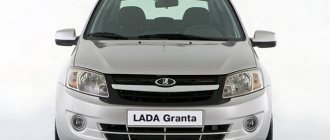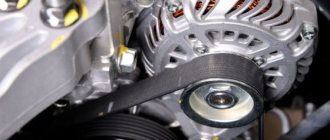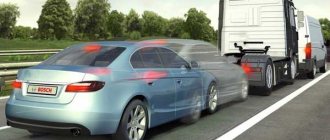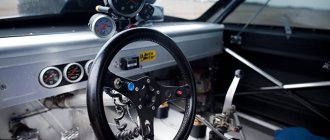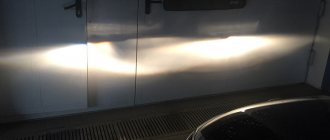Secret clearance
Crossovers of different models differ very much in their off-road “talents”, and this must be taken into account first of all when driving off the asphalt. Some models have only slightly more ground clearance than a passenger car, and automakers themselves sometimes prefer not to advertise this data. The official websites of many brands do not provide any information about the ground clearance of their crossovers.
For example, on the Opel website you will not find out that the bottom of the Antara model is separated from the road by only 175 mm, and on the Hyundai website it is not indicated that in the ix35 this figure is 185 mm. We were able to obtain these figures during test drives of these models, but they are not posted on official websites. This is understandable, because many competitors have more serious preparation: Volkswagen Tiguan - 200 mm, Renault Koleos - 206 mm, Mazda CX-5, which we are currently testing for a long time, - 210 mm. To clearly show how big the difference is between the parameters of various crossovers, we have compiled a rating of SUVs based on ground clearance (manufacturers who were embarrassed to indicate the ground clearance of models supplied to Russia on their official websites are not included in this rating).
25 compact and midsize crossovers with all-wheel drive
| 1 | Land Rover Freelander | 220 |
| 2 | Subaru XV | 220 |
| 3 | Mitsubishi Outlander | 215 |
| 4 | Subaru Forester | 215* |
| 5 | Range Rover Evoque | 212 |
| 6 | Renault Duster | 210** |
| 7 | Nissan X-Trail | 210 |
| 8 | Mazda CX-5 | 210*** |
| 9 | Renault Koleos | 206 |
| 10 | Nissan Qashqai | 200 |
| 11 | Volkswagen Tiguan | 200 |
| 12 | Suzuki Grand Vitara | 200 |
| 13 | Toyota RAV4 | 197 |
| 14 | Mitsubishi ASX | 195 |
| 15 | Suzuki SX4 | 190**** |
| 16 | Chery Tiggo | 190 |
| 17 | Kia Sorento | 185 |
| 18 | Hyundai Santa Fe | 185 |
| 19 | SsangYong Actyon | 180***** |
| 20 | Skoda Yeti | 180 |
| 21 | Lifan X60 | 179 |
| 22 | Kia Sportage | 172 |
| 23 | Nissan Juke | 170****** |
| 24 | Honda CR-V | 170 |
| 25 | Infiniti EX | 147******* |
* 215 mm - for modifications with a 2-liter engine. Forester 2.5 XS has 220 mm, Forester 2.5 XT has 225 mm. ** 210 mm - for the all-wheel drive version of the Renault Duster. Front-wheel drive has 205 mm. *** 210 mm - for the all-wheel drive version of the Mazda CX-5. Front-wheel drive has 215 mm. **** 190 mm - for the all-wheel drive version of the Suzuki SX4. Front-wheel drive has 175 mm. ***** 180 mm - for the version with 16-inch wheels. The version with 18-inch wheels has 190 mm. ****** 170 mm - for the all-wheel drive version of the Nissan Juke. For front-wheel drive - 180 mm. ******* 147 mm - Infiniti EX25. The Infiniti EX37 has 148 mm.
Crossover No. 2: Mitsubishi ASX Fuel consumption 6.1 l
The Mitsubishi ASX front-wheel drive crossover with a 1.6 MT 2WD engine ranks second among the most economical SUVs. The approximate gasoline consumption in the combined cycle does not exceed 6.1 liters per hundred kilometers. Consumption on the highway is significantly less and amounts to 5 liters per 100 km. Driving around the city increases fuel costs to 7.8 units. You can refuel your Mitsubishi with gasoline of at least class AI-95. In addition, this is a pretty fast car, which accelerates to one hundred kilometers in 10.2 seconds. The approximate cost of a Mitsubishi ASX today is 889,000 rubles
as standard.
What to remember when driving off the asphalt
First of all, it’s about the fact that any crossover is a much more “gentle creature” than an SUV. While a jeep is designed to go over large bumps while moving, the SUV's thin suspension arms won't withstand such rough handling. Let's add to this the low-slung painted bumpers and a bunch of vulnerable spots under the bottom. Only some models can boast that the engine sump is covered with metal protection from the factory. For example, the BMW X1 has it, but its direct competitor, the Audi Q3, has no protection. Many crossovers have exhaust system elements sticking out from below, sometimes the gas tank sticks out, and sometimes the rear gearbox is vulnerable. In general, rough off-road driving threatens that the car will subsequently require expensive repairs.
The only correct style of driving a crossover off-road is the so-called “expedition style”. We are not faced with the task of winning against an imaginary opponent or testing the limits of our car. The goal is to get to the target in the most efficient way without damaging the vehicle or creating problems for the crew.
Secondly, you need to understand that the crossover cross-country ability is most often limited not by how the all-wheel drive system works, and not by the ground clearance, but by the capabilities of the tires. It is difficult to imagine a person who, in his right mind, would put professional mud tires of the MT class (mud-soil) on a SUV. Tires designed for crossovers are often not much different from ordinary passenger tires, and they become so easily clogged with dirt that even in light off-road areas the car can quickly sit down.
Well, thirdly, it is worth remembering that the off-road arsenal of a car is a truncated set of what SUVs have. Moreover, this arsenal differs somewhat for different crossovers. And it’s worth understanding the specifics of your model in advance.
Chevrolet Niva
Chevrolet Niva is the cheapest SUV, the price of which will pleasantly surprise the modern car enthusiast.
A powerful all-wheel drive vehicle with a trunk volume of up to 650 liters, there are airbags on both the driver and passenger sides. Buyers note the modern stylish design, the presence of new fog lights with improved moisture and dust resistance. Table 4 - Prices for various configurations of Chevrolet Niva
| Equipment | Prices (RUB) |
| L | 450 000 |
| L.C. | 478 000 |
| L.E. | 500 000 |
| GLS | 523 000 |
| GLC | 547 000 |
Off-road arsenal
When you approach a difficult area in a car such as a Volkswagen Tiguan, Renault Koleos, Mazda CX-5 or Subaru XV, sometimes little depends on you. The electronics itself will decide when to connect the drive to the second axle when a slip occurs, and when to turn it off - the driver cannot influence this process. However, more and more SUVs still allow you to manually use one or another arsenal.
| Permanent all-wheel drive with a center differential (like, for example, the VAZ Niva or Mercedes-Benz GLK) is practically not found among crossovers. In the world of SUVs, the scheme based on a friction clutch won. In normal driving modes on reliable surfaces in the absence of slipping, traction in such drive systems by default is supplied to only one axle. As soon as the drive wheels begin to slip, the clutch automatically locks and transmits torque to the other axle. This type of drive is called automatically connected; in it, torque is supplied to the second axis on what is called “on demand”. The designs of couplings can be very diverse, for example, viscous couplings were widely used in the past; they are locked using friction forces that arise during the relative movement of the driving and driven elements of the coupling, located in a viscous fluid. The most widely used are multi-disc friction clutches, which are closed using an electromechanical or electrohydraulic drive, which operates on command from the electronics. The electronics recognizes the slipping of the wheels of the drive axle thanks to ABS sensors. The speed of such a system is significantly higher than systems with a viscous coupling; sometimes only a few degrees of rotation of the drive wheels are enough for the electronics to react and block the clutch |
Forced locking of the center coupling - this function is available in Renault Duster, Kia Sportage, Toyota RAV4, Mitsubishi Outlander and some other models. By pressing a button on the front panel or turning a knob on the center console, the driver forcibly connects the second axle. When approaching any difficult off-road section, this must be done first. And having overcome the obstacle, do not forget to switch to “Auto” mode again. The fact is that in many models the clutch overheats very quickly, after which the system will temporarily disable it and the car will remain single-wheel drive. Of course, this can happen at the most inopportune moment. It is advisable to find out in advance how long the coupling of your model can withstand. As practice has shown, the Renault Duster turns into a front-wheel drive car in just ten minutes of driving, even without any special slipping or loads. But the Land Rover Freelander rows diligently with both axles for much longer without signs of overheating. Surely its clutch will give out sooner or later, but this did not happen during our tests.
Downhill descent control system. Many crossovers can boast of this equipment, and sometimes only it can help in a very dangerous situation: a steep and slippery descent from a mountain. When trying to maintain a safe speed with the brakes, it is easy to lock the wheels and lose control. But the electronics are capable of braking each wheel individually, maintaining a safe speed. Such equipment is available, for example, in Renault Koleos, Volkswagen Tiguan, Land Rover Freelander and Toyota RAV4.
Hill start assist system. As the name implies, the task of these electronics is to prevent the crossover from rolling back when starting on an uphill slope. On models with a manual transmission, it is very useful: with its help, you can start as smoothly as possible, avoiding slipping, saving clutch and nerves. However, most Russian crossover buyers prefer automatic transmissions, so moving uphill smoothly is not a problem for them.
"Special Talents" Some models have something exotic. Land Rover developed a system that allows the car’s behavior to be “adjusted” to different types of off-road conditions many years ago for serious SUVs, and subsequently others began to use something similar. Among crossovers, only Land Rover Freelander and Range Rover Evoque have this electronics called Terrain Response. However, one must understand that in the “parquet” version the system has an extremely limited range of capabilities. After all, here it is not capable of blocking differentials and increasing ground clearance using air suspension. For crossovers, Terrain Response is responsible for ensuring that, for example, ESP does not “choke” the engine when slipping, where it is needed, and the gas pedal becomes more or less sensitive depending on which driving mode is selected. There are four of them: “asphalt”, “grass/gravel/snow”, “dirt and ruts” and “sand”.
Permanent all-wheel drive, center differential lock and reduction gear. It would seem that this serious off-road arsenal is by definition inaccessible to crossover buyers, but there are a few exceptions. Suzuki Grand Vitara, for example, can boast of all this. Mercedes-Benz GLK, having permanent all-wheel drive, has an electronically locked center differential. The Audi Q5 has a self-locking central differential (torsen), while the Subaru Forester (though only with a manual transmission) has permanent all-wheel drive with a differential that is locked using a viscous coupling.
Great Wall Hover M4
The new Great Wall Hover M4 model claims to be the most compact crossover among SUVs on the Russian market. Unlike the previous generation “Great Wall”, where a European or Japanese ancestor was clearly visible, this model cannot be clearly identified in that way.
The appearance of the car seems to have been pieced together: the front grille is similar to a grille from Volkswagen, the roofline is something from Suzuki, the rear part with a 3-window turning into the rear window evokes associations with the Skoda Yeti.
The technical characteristics of the Great Wall Hover M4 also make a good impression. Table 9 - Technical characteristics and price of Great Wall Hover M4
| Equipment | Power indicators | Price | Transmission | Engine | Drive unit |
| Standard | 99 hp | 640,000 rub. | Manual transmission | petrol | front |
| Luxury | 99 hp | 660,000 rub. | Manual transmission | petrol | front |
KamAZ 43118 technical characteristics: power take-off, transfer case, electrical circuit, brake system.
Find out about the MAZ 54323 rear axle by clicking on the link.
MAZ 64229 and its technical characteristics are here.
Dirt and ruts
A muddy country road after rain or melting snow is exactly the difficult type of off-road that you most often encounter. If there is a track, you can sit on your belly, but if there is none, the slippery ground can pull the car into a deep shoulder or to the nearest tree. When it comes to a serious jeep, off-road driving instructors recommend not to be afraid of the ruts: they say, since someone has already driven here, then there is a good chance that you can too. But in the case of crossovers, this is not at all true: the car that was moving here before you may have had much higher ground clearance.
If possible, it is better to drive “half-track” or even on top - skipping one of the “gutters” between the wheels. If you still had to move along a rut, the most important thing is not to rush. When driving slowly, a grinding sound under the bottom will indicate to you that there is still a chance to return in reverse. It’s best to do so, but turning around is dangerous! There is a high probability that the car will “wedge” diagonally, because the travel of the SUV’s suspensions is not very large. Well, diagonal hanging of the wheels (when, for example, the right front and left rear lose reliable contact with the surface) is one of the most difficult traps for any crossover. The electronics will slow down the slipping wheels, trying to imitate the locking of cross-axle differentials, but in reality this does not always help.
When driving in reverse along a rut, off-road driving instructors advise using this technique: simultaneously turning the wheels while adding gas. Thus, the car is “thrown out” of the track. There is no need to rush; on the contrary, you need to move as slowly as possible, avoiding severe slipping. Does not work? Try again as you move forward. Shake the steering wheel left and right, rocking the car between the edges of the track until it catches the resonance and jumps up on its own. To pull the rear wheels out, sometimes it is necessary to accelerate sharply, giving inertia, but this must be done carefully. And, of course, look back periodically. Perhaps there is an opportunity to drive nearby, sometimes right through a forest or across an untouched field, rather than meddle in a potentially disastrous place.
Great Wall Hover M2
When wondering which SUV is the cheapest and still meets all the requirements, many buyers agree.
So, if you read the reviews on automobile portals and forums, it will become obvious that one of the most economical models that fully meets all the requirements of comfort, functionality, maneuverability and safety is the Great Wall Hover M2. The maximum speed of the car is 158 km/h with a very significant weight, fuel consumption is from 6.2 liters. Three trim levels: Standart, Luxe and Edit. Table 7 - Cost of Great Wall Hover M2 models
| Equipment | Cost, rub. |
| Standard | 530 000 |
| Lux | 590 000 |
| Elite | 620 000 |
Steep ascents and descents
When driving a crossover, it is better to always stick to at least some roads and not storm hills, which the SUV is clearly not designed to conquer. However, even a dirt road that rises steeply is fraught with danger. After rain, the climb can be very slippery, and halfway to the top the car will skid helplessly. And if the wheels have good grip on the surface, there is a danger of stalling when entering a very steep slope. Here you need to immediately press the brake so that the car does not start to roll back. If the ascent failed, we slowly descend back.
| Many people have no idea that there are special off-road driving courses for crossover owners. What to do: most prefer to comprehend this science on their own |
When driving uphill, it is necessary to maintain a balance of inertia and wheel adhesion to the road. If it’s dry under the wheels, it’s better not to rush: you don’t always know what awaits beyond the bend. But if the climb is slippery or loose, there’s no way without a reserve of speed. That is, a slight overclocking will be required.
Descents are dangerous because the car can slip into an uncontrolled slide. If your car is equipped with a hill descent assist system, do not forget to turn it on, and then the risk of losing control will be minimal. But on all other crossovers you will have to use specific techniques. When the car begins to slide, an unprepared driver will desperately press the brake, but it is useless. With locked wheels, the SUV will continue to slide down under the influence of gravity. ABS will not help here: at speeds less than 5 km/h it does not turn on, and during a slow slide, when all four wheels are locked, it generally “thinks” that the car is standing still. The best thing to do in this situation is to add gas against your instincts! The wheels must start spinning at the same speed as the car is moving - this is the only way the car will be controllable again. And after control of the car has been restored, you can try to smoothly slow down again.
VAZ (Lada) 2121
VAZ (Lada) 2121: the cheapest all-wheel drive SUV.
The car is available in two trim levels: standard and luxury. Table 1 - Technical characteristics and price of VAZ (Lada) 2121
| Equipment | Engine capacity | Price | Maximum speeds | Energy consumption |
| Luxury | 1,7 | 446 700 | 137 km/h | 11.5 (within the city) 8.3 (on the highway) |
| Standard | 1,7 | 435 000 | 137 km/h | 11.5 (within the city) 8.3 (on the highway) |
The car has been modernized and adapted to the requirements of European and domestic consumers. VAZ (Lada) 2121 has always been highly valued both in Russia and abroad. Due to its unique qualities: practicality, long-term operation, body strength and sufficient engine power. This is the cheapest SUV to date.
Ural 4320 technical characteristics: device (photo, video, price).
KamAZ 5320: photos, videos, technical characteristics.
Sand and loose soil
These are very treacherous places that we do not recommend going into in a crossover. But if you suddenly find yourself in such places, then you can’t do without professional jeep techniques.
If there is dry and loose sand ahead, you should reduce the tire pressure to 1 atmosphere in advance. The area of the contact patch with the surface will increase: firstly, it will reduce the specific pressure on the ground (the car will simply sink less), and secondly, it will increase the reliability of adhesion to the surface. You need to start moving as smoothly as possible, keeping the steering wheel straight. You should drive at “steady throttle”, as any slipping or deceleration will cause the car to stall.
No. 8: SsangYong Actyon Fuel consumption 8.2 l
The next all-wheel drive crossover SsangYong Actyon also claims to be the most economical SUV in terms of price. A fairly powerful 2.0 D MT 4WD engine accelerates from zero to one hundred in 15 seconds. As for fuel consumption, this is not the most economical option. Judge for yourself: per 100 km the car consumes 10.5 liters in the city.
In the combined cycle, consumption drops to 8.2 units. On the highway, SsangYong consumes neither more nor less - 6.9 liters. The class of gasoline used is AI-95 and higher. The cost of the car is in the middle price category and amounts to 1,100,000 rubles
.
Ford
The vast majority of manufacturers do not provide official data for their crossovers on what the maximum ford depth is. In fact, this means that this model is not designed to overcome water obstacles at all. Even driving through a very deep puddle can damage it. A sharp cooling of differentials (and any other units that have valves to relieve excess pressure) leads to a drop in pressure in them, and the units begin to suck water inside themselves. Even serious SUVs are susceptible to this, so when preparing a jeep for off-roading, special tubes are connected to the top from those same pressure-equalizing valves. Of course, such tuning for a crossover is an unnecessary luxury. This car is not for such purposes. However, there are exceptions.
Land Rover assures that its crossovers can overcome water obstacles up to 50 cm deep. Moreover, this applies not only to the austere-looking Freelander, but also to the glamorous Evoque. Another example is the Mercedes GLK. It is also officially allowed to “swim” on it. However, we must not forget that a puddle of similar depth can conceal approximately the same dangers that a river or stream hides, namely a stone, piece of iron or a hole. Therefore, the main rule: if in any doubt, measure the depth with a stick of suitable length. When going to an unfamiliar area, it is better to have rubber boots with you so you can feel the bottom with your feet.
You should cross a water obstacle in low gear, maintaining a constant speed so that the wave created by the front bumper runs in front of the car. This way it creates a depression in front of the car - the risk of flooding the engine through the intake system and getting a water hammer will be minimal.
Vortex Tingo
A powerful, ergonomic crossover with increased ground clearance, high cross-country ability and economical fuel consumption.
If you are interested in the question of which SUV is the cheapest to maintain, then you should take a closer look at this model. The 2012 car, unlike previous models, received completely new head optics and rear lights. The 5th door and radiator grille were restyled. Table 8 - Technical characteristics and price of Vortex Tingo
| Engine power | Engine capacity | Consumption indicators | Drive / Gearbox | Price |
| 132 hp (170 Nm) | 1.8 l | from 7 l | Front/Five-speed | 590,000 rub. |
What to do when stuck
The steeper the jeep, the further you have to go behind the tractor. Owners of crossovers are “lucky”: firstly, it’s often not far to go get a tractor, and secondly, due to the fact that the mass of such models is much smaller than that of SUVs, not only a tractor, but also another crossover or SUV can help.
In the event that the car is stuck in mud or sand, a jack will also help - when using it, you may not even need a “tractor”. Using a jack, you should raise the body to place a board or branches under the slipping wheels. You should also place a board under the jack itself to prevent it from digging into the ground. Well, a shovel will be very useful. This is a tool with a user-friendly interface: even a beginner will understand what to do with it. However, let's be realistic, where does the shovel come from in the crossover?
The crossover is designed not so much for intentional off-road trips, but for situations where off-road conditions suddenly occur to you. If a passenger car forces you to turn back, then a crossover will most often help out. You just need to drive carefully, not forgetting the rules of off-road driving. By the way, we have already talked about many of them in our video “Off-Road Driving School”.
Discussion on the club FORUM
No. 6: Ford Kuga Fuel consumption 6.2 l
Among the most economical SUVs is the all-wheel drive Ford Kuga with a turbocharged 2.0 TDCi MT 4WD engine. In the urban cycle, the car consumes up to 7.4 liters of fuel, in the mixed cycle – 6.2 units. Consumption on the highway drops significantly and amounts to 5.5 liters per hundred.
Ford Kuga runs on diesel fuel. Its acceleration speed to 100 km is 11.2 seconds. As for the cost of the Ford Kuga, it is not one of the most budget options among crossovers. The average price for such a car is 1,774,000 rubles
.

